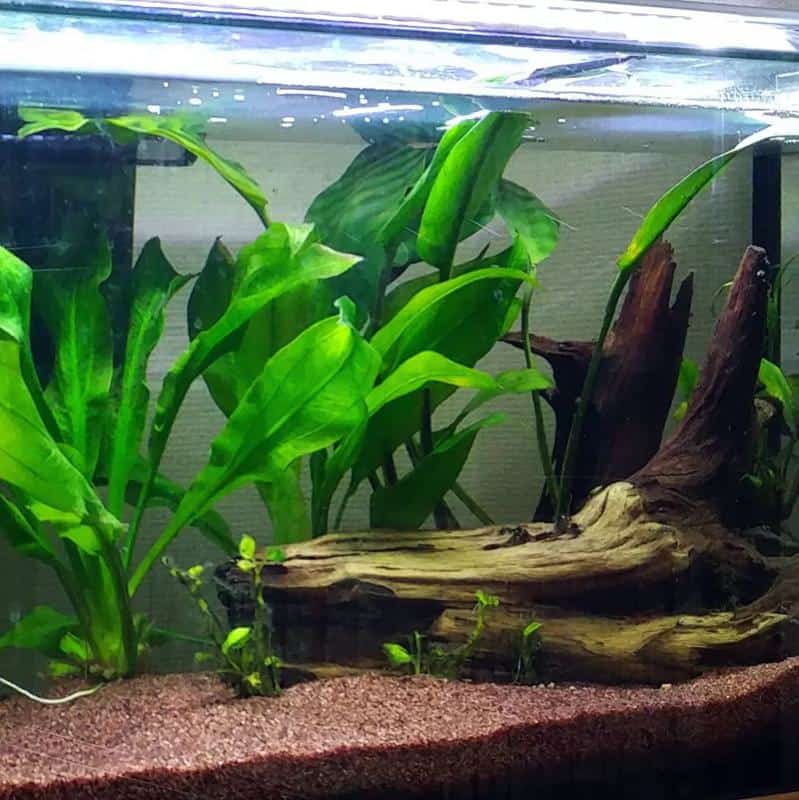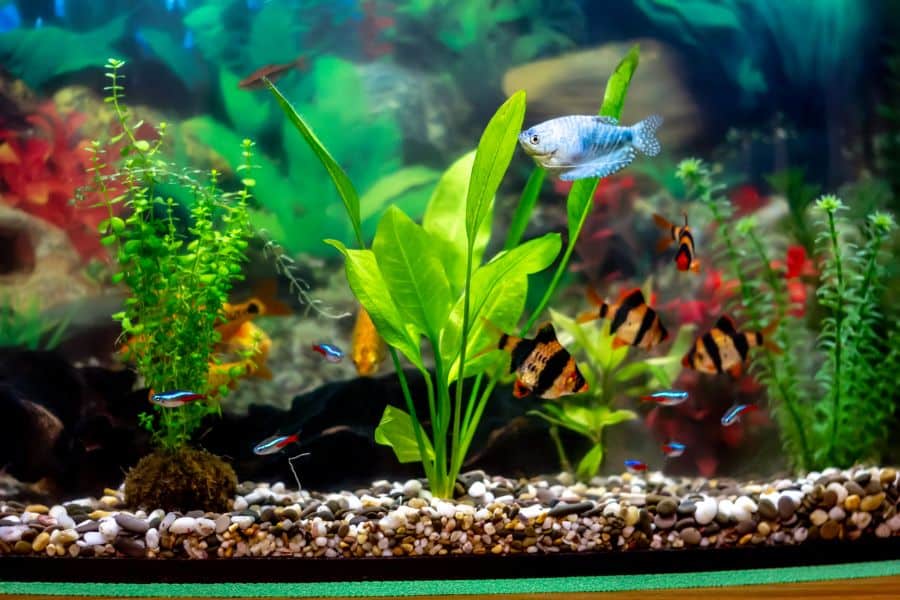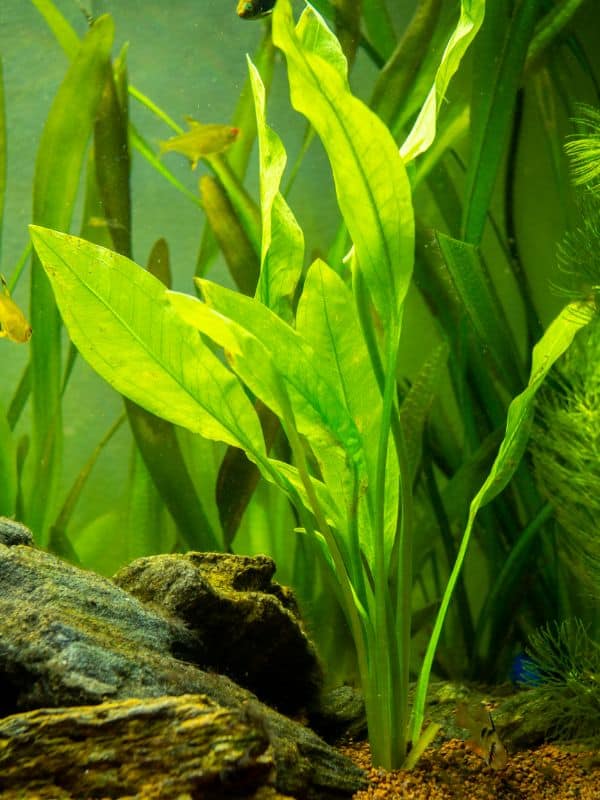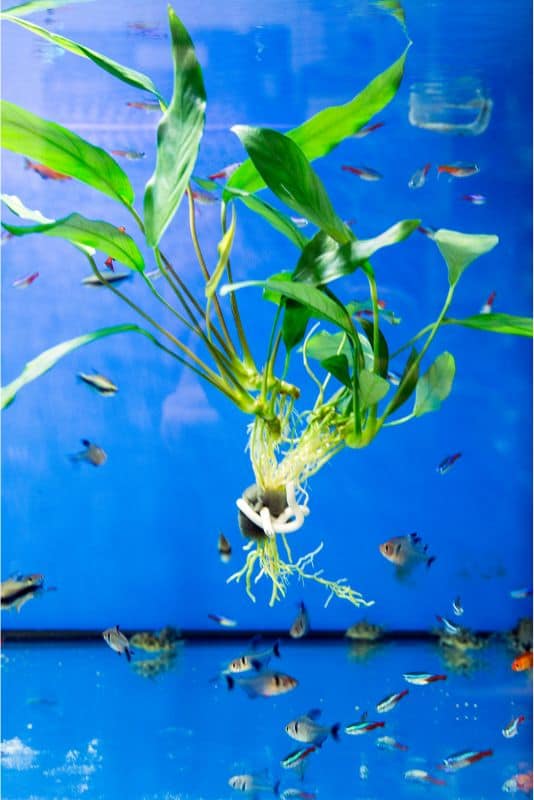There are hundreds of choices for aquarium plants, and deciding which to use for your tank may be difficult.
You have probably enlisted the help of search engines or asked some friends, and we are pretty sure Google or your buddy may have mentioned the Amazon Sword since it is one of the most popular freshwater aquarium plants.
Many of us are considering the Amazon Sword due to its popularity, availability, and out of personal curiosity. But the question is: how deep is your knowledge about them?
Join us in this article as we dig deep and learn everything you should know about the Amazon Sword plants.
Description and Origins
You may know what an Amazon Sword looks like, but familiarity with its appearance alone is inadequate.
Biologically, the Amazon Sword (Echinodorus sp.) are flowering water plantain growing in freshwater ponds and marshes under Family Alismataceae. Aside from being herbaceous plants (or non-wood producers), they have lush green leaves with a sword-like appearance and can grow up to 2 feet long.
Ecologically, this popular freshwater aquarium plant originates from the World’s largest forest – the Amazon in South America. They thrive naturally in the river basin with their roots submerged deep in the mud or sand and their leaves exposed to the air, making them semi-aquatic plants.
Semi and Fully Aquatic Traits
We just mentioned that Amazon Swords are semi-aquatic in their wild habitat. With us in the aquarium hobby, we can now ask this question: do we adapt the semi-aquatic traits of Amazon Swords or find ways for them to become fully submerged?
While adapting the semi-aquatic behavior of Amazon Sword plants is natural, aquarists and plant breeders have found a way for the plant to become fully submerged. They use small plastic pots to contain and slowly acclimatize the plant until fully immersed.
It is why most Amazon Swords you see for sale in pet shops are already potted.
How to Plant Amazon Sword
Although they are already potted and easy to take care of, it doesn’t mean that you just throw them in the tank and leave them behind to grow by themselves.
For your Amazon Sword plant to have a nice growth, please follow these planting procedures:
Pot Removal
You can plant your Amazon Sword with their pots on. However, you are restricting the growth and development of their root system.
The roots of your Amazon Swords need to spread out and anchor firmly in the substrate to support the weight of their vertical growth. With this, removing their pots is recommended before planting.
Similarly, when you remove them from their pot, you can see how thick or thin the plantings are and how many branches there are. If the plantings are dense or have too many stems, you can divide them into two.
Substrate Preparation
Substrate plays a significant role in growing your Amazon Sword plant, particularly the type of substrate and its thickness.
While Amazon Swords can grow on most substrates, they grow best on sand and small or fine gravel. Regardless of which substrate you choose, the critical factor is the thickness.
Amazon Sword plants need a thick substrate (at least 2.5 inches deep) for their roots to anchor firmly and support their growth. If your substrate is thin, its roots cannot hold on tight, and the plant may uproot easily and become dislodged.
Actual Planting
Planting your Amazon Sword should only begin if you have removed them from their pots and prepared a thick substrate.
The easiest way to plant your Amazon Sword is with your bare hands. Using your fingers, you can dig a hole in the substrate, fix the plant by burying the roots, and return the displaced substrate in the remaining spaces of the hole you just created.
Digging can disturb your substrate, but you can prevent this by using tweezers. Just clip the plant gently and push it downwards until you bury the roots completely.
Regardless if you choose to plant with your bare hands or with a pair of tweezers, what is more important is that you only bury its roots and allow its crown (or top part) to be free from any obstruction, since it is where the stems and leaves come out and covering them with sand or gravel will not just stunt their growth, but may also lead to their death.
Placement and Spacing
Amazon Swords are background plants. We recommend placing them at the side or back part of the tank. Otherwise, when you set them at the center or in front, they will cover other plants once their leaves start to bloom and flourish.
If you have more than one Amazon Sword to plant in a single tank, you must practice proper spacing between plants (at least a couple of inches between plants). In this way, you prevent leaves from intertwining between plants while giving them enough space for growth.
Add Root Tabs
Aside from photosynthesis, aquarium plants get nutrition by absorbing nutrients in the water. In the case of the Amazon Swords, they are root feeders. They rely heavily on their root system to extract nutritional supplements.
Initially, your substrate may be rich in nutrients. But as the roots of the Amazon Sword absorb them, they become nutrient deficient.
Adding root tabs in your substrate prevents the malnourishment of your Amazon Sword. These are nutrient-enriched tablets placed and buried near the root system.
Just be aware that you only place the root tabs after you have planted your Amazon Sword. The tablet will start reacting and release nutrients once it gets in contact with the water.
Maintenance of Amazon Sword Plants
With their tolerance to a wide range of parameters, Amazon Sword plants are easy to care for, making them ideal for beginners. But it doesn’t mean that after planting, you leave them behind like in their wild habitat.
Remember that you have planted your Amazon Sword in a tank that is a closed environment and requires upkeep on your part.
Here are some of the plant maintenance you can do to your Amazon Sword:
Lighting

The Amazon Sword plant can tolerate a wide range of lighting intensity.
Ideally and in practice, Amazon Sword plants are kept under moderate to high lighting conditions for 10 to 12 hours a day. In this way, you mimic their length of sunlight exposure and the variety of lighting intensities in the wild, where some are directly exposed to the sun, while some are shaded.
Using the right lighting system will broadly help the overall growth of your Amazon Sword plants.
Avoid using incandescent bulbs. Aside from their high wattage (which leads to higher electricity bills), they emit heat and only have a monotone color. We recommend using LEDs, and if you have an extra budget, choose the model with a pre-program mode where you can automate the time of operation and brightness mode.
If you’re using a simple tank and don’t have a lighting system, you can still keep Amazon Swords since they can function as a low-light plant. Just don’t expect your plant to grow well compared to those with a lighting system.
Temperature
Amazon Swords are tropical plants. In their wild habitat, they thrive in warm river basins with water temperatures ranging from 84 to 86 F (29 to 30 C).
You will have no problem attaining this temperature range if your location is in the tropics. However, if your area is predominantly sub-tropical, you may need a heater with a thermostat. In this way, you can regulate and control your tank’s water temperature.
In an aquarium setting, Amazon Sword plants love to thrive in waters with temperatures ranging from 72 to 82 F (22 to 28 C). If you fail to control, and your temperature drops to 70 F (21 C), expect your plants to become weak and may soon die.
Water Flow
Amazon Swords naturally thrive in marshes and ponds of the Amazon river basin. These bodies of water are either semi-stagnant or have low water flow rates, and the only time water flows freely is during the rainy season.
We recommend a low water flow in keeping your Amazon Sword plants. Otherwise, if you place them in a tank with strong water flow, they cannot anchor their roots firmly to the substrate, and their elongated leaves can easily be carried away by the strong water current, uprooting the plant in the end.
CO2 Supplement
We know we got your attention when we mentioned that Amazon Swords are not fast growers, and it takes time for them to reach their maximum length. But there is a trick that makes your plants grow like crazy.
Aside from the root tabs you have placed in the substrate after planting, supplementing it with CO2 will significantly boost their growth. Remember that in photosynthesis, plants take carbon dioxide and release oxygen.
The easiest way to do this is by adding CO2 Booster drops. If you wish to have a high-tech setup, you can install a CO2 generator where a surface-supplied canister guarantees a constant level of C02 in your tank water.
Add Algae Eaters
Since Amazon Swords slowly grow while being exposed to moderate to intense lighting, the tendency is that you are also simultaneously growing algae.
Algae growth may not necessarily be in the plant itself, but it commonly grows in the substrate, filter tube, or any solid object. Once the population of algae blooms, it will compete with your plant in using up the nutrients in your water.
To prevent this, add algae-eaters like snails and shrimp and algae-eating fish like the Plecostomus.
Trimming Your Amazon Sword Plant
If you follow the steps we mentioned earlier, expect your Amazon Sword plants to reach their maximum height and may extend their leaves out of the water. When this time comes, trimming is required. Otherwise, the leaves of your Amazon Sword may reach and block your lighting system, worst, may cause electrical short circuit.
But trimming is not just about trimming. Trimming without knowing the proper way would do more harm to the plant. There is a way that causes no damage while providing space for future growth.
Do Not Uproot
Working on the plant is easier without water and out of the tank. But you can only do this by uprooting them. No. Never uproot your Amazon Sword just for the sake of trimming.
Work on the plant while being rooted. You can lessen the water level of your tank so you can easily handle and work on the plant. It is also a great reason why you do a water change.
Remove Damaged, Dead and Rotting Leaves
Do not mow the leaves in such a way that every leaf aligns with the surface of the water. A healthy leaf should not be trimmed, and do not worry if your leaves have different length since it is perfectly normal.
What you do instead is remove any dead or rotting leaves. You can differentiate the healthy green leaves from the dead and rotting since they are colored dull brown or transparent.
Do not use your hands and pull out the rotting leaves. Instead, use a pair of scissors and cut the rotting leaves in their base. Start cutting the perimeter leaves and work your way towards the center, if there’s any rotting leaves.
Propagating Amazon Sword Plants
In the wild, bees pollinate the Amazon Sword. But in a tank setup, it employs a different mode for them to reproduce.
Instead of pollination, they send out rhizomes (or runners in the aquarium language) that shoot out from their roots. You can easily identify them as the rhizomes are short, thick, and white. As the runners spread, they produce a new root system which will become a new plant.
When the new plant reaches 3 to 5 inches tall, you can cut them from its mother rhizome and replant them in another tank.
Melting of Amazon Sword
Melting is another term used in the aquarium hobby that describes plant withering due to several factors.
With Amazon Swords, examine the leaves where their current state will help you trace the cause of their melting.
If you notice their leaves change color (from green to yellow or brown), it means your plant is nutrient deficient. As previously described, you can add either root tabs or supplement with CO2.
In some cases, the leaves appear burnt and crisp with folded edges on their blade. It clearly indicates that your plant has been exposed to too much lighting. To address this, you can either transfer your plant to a new location or provide a surface shade, which is easier to do.
In a worst case scenario, you may see your leaves falling off. While this is an extreme type of melting, the cause of this damage is simply attributed to either lack or too much water. Increase or decrease your water level accordingly.
Diseases in Amazon Sword
While Amazon Swords are easy to care for, they are prone to diseases mostly linked to fungal and bacterial infections.
Root Rot
Caused by a fungal infection, root rot is the most common disease suffered by Amazon Sword plants. While you cannot see this since their roots are embedded in the substrate, you will notice that the plant slowly turns pale. It is only when you uproot the plant that you can determine the condition of its roots.
Leaf Spot
Caused by both fungal and bacterial infections, the leaf spot disease is not commonly occurring in Amazon Sword plants.
While it is uncommon, it is a sore in the eye and greatly degrades the aesthetic value of your tank. The spots are visible to the eyes and may scatter across many leaves from a single plant.
Crown Rot
Opposite to the root rot disease is the crown rot disease. Instead of being hidden beneath the substrate, this fungal infection attacks the upper parts of the leaves, appearing like it is melting. The only difference is that crown rot disease does not create wavy edges on the leaves.
To address all these diseases being suffered by your Amazon Sword, you can either cut the damaged part (as described in the trimming procedure) or add drops of anti-fungal and anti-bacterial solution specifically designed for aquarium plants (not fish). Be sure to read the manufacturer’s instructions as overdosing can significantly harm your plant.
Also Read:
Frequently Asked Questions
What to Look for When Buying Amazon Sword Plants?
Only buy Amazon Sword plants that are healthy, have bright green leaves, developed root systems, and are free from diseases.
By closely examining the plant, look for damage or rot in its roots, stems, and leaves. If you see one, then that plant is not for you. Pass and proceed to your next selection.
Can You Grow Amazon Sword without Substrate?
Yes, but it will only live for a few days.
Amazon Sword plants rely heavily on how their roots are buried to support the weight of their growth and nutrient feeding.
If your tank does not have a substrate (just raw and bare), you can still keep Amazon Swords by placing them in pots.
What Fish Are Compatible with Amazon Sword Plants?
Amazon Sword plants do well in a community fish tank. Therefore, they are compatible with most freshwater aquarium fish.
However, there is always an exception. These are species of fish that are known for their nuisance behavior, like goldfish, cichlids, and Oscars.
Conclusion
Now that you have extensive knowledge about Amazon Sword plants, it is time to get hands-on and try keeping this popular freshwater plant in your tank. For sure, there are imperfections along the way. But with their ease of care and tolerance to a wide range of parameters, handling them may not be as difficult.
Once you perfect the growing and breeding of the Amazon Sword plant, you can surely sit back, relax, and stare at how beautiful these plants are while thinking of taking on the challenge of keeping more challenging plants.


